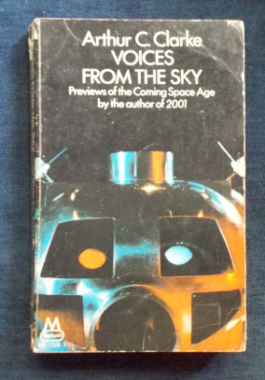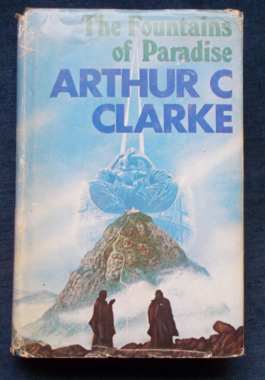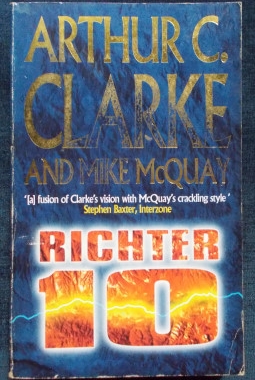An immensely readable and stimulating collection of essays examining the enormous possibilities the human race now has for creativity and destruction. Against Orwell's ominous date 1984 he has deliberately set the hopeful word Spring because he feels the worst of the world's long winter may well be over. Clarke's passionate interest in space exploration, vast knowledge of technological and scientific developments and his informed, optimistic humanism are communicated in a style that will strike a responsive chord in the hearts and minds of all readers concerned for the future of humankind on - and off - Earth.
-

-
 Clarke looks back at the early days of the science fiction field, offering some humorous anecdotes and insightful observations of the Golden Age notables of the genre. He reminisces on Astounding Science Fiction (now Analog) and its effect on him as a schoolboy; it's half Clarke's two-pronged memoirs and half chronicle of his scientific/engineering career. Told with humor and humility and throughout, his lifelong love of learning shines through. Cover art by Chris Consani.
Clarke looks back at the early days of the science fiction field, offering some humorous anecdotes and insightful observations of the Golden Age notables of the genre. He reminisces on Astounding Science Fiction (now Analog) and its effect on him as a schoolboy; it's half Clarke's two-pronged memoirs and half chronicle of his scientific/engineering career. Told with humor and humility and throughout, his lifelong love of learning shines through. Cover art by Chris Consani. -
 Previews of the coming space age...The universe is full of voices, calling from star to star in myriad tongues. One day we shall join that cosmic conversation, though it may be ages before we cross the mega-mega-miles sundering us from our equals, and our masters. This is Clarke's log of a voyage which has only just begun - Man's odyssey from Earth, his first home, among the planets, to the stars, and across the universe. There are also plenty of snippets of his life slipped into the essays.
Previews of the coming space age...The universe is full of voices, calling from star to star in myriad tongues. One day we shall join that cosmic conversation, though it may be ages before we cross the mega-mega-miles sundering us from our equals, and our masters. This is Clarke's log of a voyage which has only just begun - Man's odyssey from Earth, his first home, among the planets, to the stars, and across the universe. There are also plenty of snippets of his life slipped into the essays. -
 The compelling story of the launching of Prometheus - Earth's first true spaceship - and of the men who made it happen. Dirk Alexson: Chronicler of the greatest space adventure of all time, he was chosen to immortalize the incredible story of the men and their heroic mission. Sir Robert Derwent: Direct-General of Interplanetary -- London Headquarters for the international space-flight project -- he was the man who got the mission off the ground and into the pages of history. Professor Maxton: The world's leading atomic engineer, he designed the huge ship's drive units and he waited with the rest of the world to see if the project would be a success... Cover art by Gordon C. Davies.
The compelling story of the launching of Prometheus - Earth's first true spaceship - and of the men who made it happen. Dirk Alexson: Chronicler of the greatest space adventure of all time, he was chosen to immortalize the incredible story of the men and their heroic mission. Sir Robert Derwent: Direct-General of Interplanetary -- London Headquarters for the international space-flight project -- he was the man who got the mission off the ground and into the pages of history. Professor Maxton: The world's leading atomic engineer, he designed the huge ship's drive units and he waited with the rest of the world to see if the project would be a success... Cover art by Gordon C. Davies. -
 In 2124 A.D. the brilliant engineer Vannevar Morgan has evolved a method of building a gigantic 'Space Elevator' to transport men and materials out of the Earth's atmosphere, thus marking the true beginning of Man's interplanetary civilisation. But there's a major obstacle before this awesome concept can become reality: the only point on Earth suitable for the launch site is the peak of a sacred mountain jealously guarded by monks who have inhabited the site since time immemorial. Will their resistance be overcome? Cover art by Terry Oakes.
In 2124 A.D. the brilliant engineer Vannevar Morgan has evolved a method of building a gigantic 'Space Elevator' to transport men and materials out of the Earth's atmosphere, thus marking the true beginning of Man's interplanetary civilisation. But there's a major obstacle before this awesome concept can become reality: the only point on Earth suitable for the launch site is the peak of a sacred mountain jealously guarded by monks who have inhabited the site since time immemorial. Will their resistance be overcome? Cover art by Terry Oakes. -
 Five hundred years before the events in The Songs of Distant Earth, Earth's sun went nova, destroying Earth and the other planets of the solar system. There was just enough warning to evacuate survivors in hyperships, each carrying one million sleepers in suspended animation, as well as the gene banks of plants and animals. The Magellan, experiencing considerable erosion from interstellar space debris, stops at the planet Thalassa to construct a new shield. The Thalassans are happy to help the interstellar travellers but matters get complicated when the travellers are tempted by the idyllic lifestyle on Thelassa, and the Thelassans are attracted by the adventure of deep-space voyage... and then Commander Lorenson falls in love in Mirissa, a Thelassan girl. Cover art by Michael Whelan.
Five hundred years before the events in The Songs of Distant Earth, Earth's sun went nova, destroying Earth and the other planets of the solar system. There was just enough warning to evacuate survivors in hyperships, each carrying one million sleepers in suspended animation, as well as the gene banks of plants and animals. The Magellan, experiencing considerable erosion from interstellar space debris, stops at the planet Thalassa to construct a new shield. The Thalassans are happy to help the interstellar travellers but matters get complicated when the travellers are tempted by the idyllic lifestyle on Thelassa, and the Thelassans are attracted by the adventure of deep-space voyage... and then Commander Lorenson falls in love in Mirissa, a Thelassan girl. Cover art by Michael Whelan. -
 Here is Arthur C. Clarke at his most impish and light-hearted: This volume includes: Silence Please; Big Game Hunt; Patents Pending; Armaments Race; Critical Mass; The Ultimate Melody; The Pacifist; The Next Tenants; Moving Spirit; The Man Who Ploughed the Sea; The Reluctant Orchid; Cold War; What Goes Up; Sleeping Beauty; The Defestration of Ermintrude Inch. Cover art by David O'Conner.
Here is Arthur C. Clarke at his most impish and light-hearted: This volume includes: Silence Please; Big Game Hunt; Patents Pending; Armaments Race; Critical Mass; The Ultimate Melody; The Pacifist; The Next Tenants; Moving Spirit; The Man Who Ploughed the Sea; The Reluctant Orchid; Cold War; What Goes Up; Sleeping Beauty; The Defestration of Ermintrude Inch. Cover art by David O'Conner. -
 Based on the screenplay by Stanley Kubrick and Arthur C. Clarke. A group of primates is singled out to receive information from a superior outside force which will speed up their development into mankind. Later, men excavate a huge monolith from the Moon's surface - a monolith which emits a strange and, to them, incomprehensible signal. Upon its discovery the monolith launches into deep space, its task of watching over Man, now that he has reached the level of sophistication necessary to find it, being over. This theme continues building into a a massive climax.
Based on the screenplay by Stanley Kubrick and Arthur C. Clarke. A group of primates is singled out to receive information from a superior outside force which will speed up their development into mankind. Later, men excavate a huge monolith from the Moon's surface - a monolith which emits a strange and, to them, incomprehensible signal. Upon its discovery the monolith launches into deep space, its task of watching over Man, now that he has reached the level of sophistication necessary to find it, being over. This theme continues building into a a massive climax.



